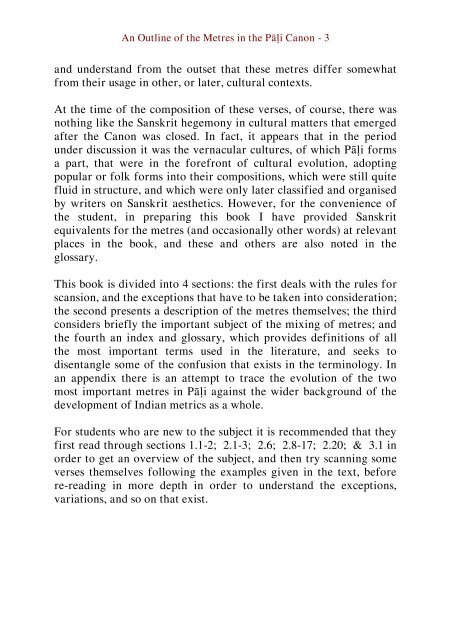An Outline of the Metres in the Pāḷi Canon
A concise but thorough explanation of the metres that are found in the Pāli canon, along with examples and glossary.
A concise but thorough explanation of the metres that are found in the Pāli canon, along with examples and glossary.
Create successful ePaper yourself
Turn your PDF publications into a flip-book with our unique Google optimized e-Paper software.
<strong>An</strong> <strong>Outl<strong>in</strong>e</strong> <strong>of</strong> <strong>the</strong> <strong>Metres</strong> <strong>in</strong> <strong>the</strong> <strong>Pāḷi</strong> <strong>Canon</strong> - 3<br />
and understand from <strong>the</strong> outset that <strong>the</strong>se metres differ somewhat<br />
from <strong>the</strong>ir usage <strong>in</strong> o<strong>the</strong>r, or later, cultural contexts.<br />
At <strong>the</strong> time <strong>of</strong> <strong>the</strong> composition <strong>of</strong> <strong>the</strong>se verses, <strong>of</strong> course, <strong>the</strong>re was<br />
noth<strong>in</strong>g like <strong>the</strong> Sanskrit hegemony <strong>in</strong> cultural matters that emerged<br />
after <strong>the</strong> <strong>Canon</strong> was closed. In fact, it appears that <strong>in</strong> <strong>the</strong> period<br />
under discussion it was <strong>the</strong> vernacular cultures, <strong>of</strong> which <strong>Pāḷi</strong> forms<br />
a part, that were <strong>in</strong> <strong>the</strong> forefront <strong>of</strong> cultural evolution, adopt<strong>in</strong>g<br />
popular or folk forms <strong>in</strong>to <strong>the</strong>ir compositions, which were still quite<br />
fluid <strong>in</strong> structure, and which were only later classified and organised<br />
by writers on Sanskrit aes<strong>the</strong>tics. However, for <strong>the</strong> convenience <strong>of</strong><br />
<strong>the</strong> student, <strong>in</strong> prepar<strong>in</strong>g this book I have provided Sanskrit<br />
equivalents for <strong>the</strong> metres (and occasionally o<strong>the</strong>r words) at relevant<br />
places <strong>in</strong> <strong>the</strong> book, and <strong>the</strong>se and o<strong>the</strong>rs are also noted <strong>in</strong> <strong>the</strong><br />
glossary.<br />
This book is divided <strong>in</strong>to 4 sections: <strong>the</strong> first deals with <strong>the</strong> rules for<br />
scansion, and <strong>the</strong> exceptions that have to be taken <strong>in</strong>to consideration;<br />
<strong>the</strong> second presents a description <strong>of</strong> <strong>the</strong> metres <strong>the</strong>mselves; <strong>the</strong> third<br />
considers briefly <strong>the</strong> important subject <strong>of</strong> <strong>the</strong> mix<strong>in</strong>g <strong>of</strong> metres; and<br />
<strong>the</strong> fourth an <strong>in</strong>dex and glossary, which provides def<strong>in</strong>itions <strong>of</strong> all<br />
<strong>the</strong> most important terms used <strong>in</strong> <strong>the</strong> literature, and seeks to<br />
disentangle some <strong>of</strong> <strong>the</strong> confusion that exists <strong>in</strong> <strong>the</strong> term<strong>in</strong>ology. In<br />
an appendix <strong>the</strong>re is an attempt to trace <strong>the</strong> evolution <strong>of</strong> <strong>the</strong> two<br />
most important metres <strong>in</strong> <strong>Pāḷi</strong> aga<strong>in</strong>st <strong>the</strong> wider background <strong>of</strong> <strong>the</strong><br />
development <strong>of</strong> Indian metrics as a whole.<br />
For students who are new to <strong>the</strong> subject it is recommended that <strong>the</strong>y<br />
first read through sections 1.1-2; 2.1-3; 2.6; 2.8-17; 2.20; & 3.1 <strong>in</strong><br />
order to get an overview <strong>of</strong> <strong>the</strong> subject, and <strong>the</strong>n try scann<strong>in</strong>g some<br />
verses <strong>the</strong>mselves follow<strong>in</strong>g <strong>the</strong> examples given <strong>in</strong> <strong>the</strong> text, before<br />
re-read<strong>in</strong>g <strong>in</strong> more depth <strong>in</strong> order to understand <strong>the</strong> exceptions,<br />
variations, and so on that exist.

















